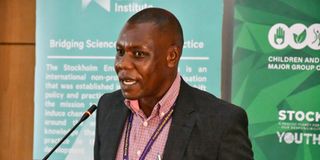Premium
Why involving the youth in climate decisions matters

Philip Osano, Centre Director of SEI Africa speaks during this year's Youth Environment Assembly at World Agroforestry Centre in Gigiri, Nairobi on February 19, 2022.
Involving the youth in key decisions pertaining to the environment could help a great deal to curb the perils of climate change, experts have said.
Participating in this year’s Youth Environment Assembly at World Agroforestry Centre in Gigiri, Nairobi, environmentalists asked world governments to give the youth more opportunities to contribute to the sustainability of nature and protection of future generations.
“Although African youth voices are being heard in multilateral processes, active youth participation in real decision making is still lacking. There’s need for more meaningful inclusion of African youth voices across the board,” said Richard Matey, African regional facilitator, Children and Youth Major Group at United Nations Environment Programme (UNEP).
Speaking from Palestine, Ahmed Ouda, a Stockholm+50 Youth Taskforce member said many youths in environmental campaigns only target to have more impact, with the goal being to see the planet become a better place.
Negotiations
“We want to be at the table of negotiations: As a taskforce, we need to reflect our position on global policies in better managing our environment,” he said.
Ms Pamela Gitobu of the Bamboo Association of Kenya said Kenyan youth will have to do more campaigns to awaken everyone about the dangers in the environment.
“Cancer is everywhere because of environmental pollution. We need to engage our politicians on environmental issues. For sure we need to be included in decision making. Our animals are suffering, our environment is struggling,” said the founder of Green Village, a community based organization in Meru.
The event, which was a blend of online and in-person participation, brought together youth leaders from across the globe and debated on structures, processes and initiatives through which youth can work together globally and consult meaningfully on a national and regional level.
“"Your voices are influential, make them heard when and where decisions are made," urged Swedish Ambassador to Kenya Caroline Vicini.
Deputy Director, Governance Affairs at UNEP Mr Ulf Bjornholm reminded youths that their biggest role in environmental protection is raising awareness, and young environmentalists can start by following their inspirations when creating ecological preservation projects.
Underscoring that there is never one right way to engage in environmental negotiations, he asked the youth to use all available avenues to voice their concerns regarding climate action and conservation.
“Think 30 or 40 years ahead because world leaders are listening to the youth. Attend exhibitions, interact with delegates and use social media to push the environmental agenda that suits you best. All these ways are important,” he said.
Emmanuel Danso, a young environmentalist, asked policy makers to break down environmental jargon so citizens in the grassroots can comprehend the global climate crisis and participate in protecting the environment.
Climate stories
“We need to tell climate stories in a simple language so we include everyone,” he said.
Over the past few years, delegates heard, youth participation has received significant political attention but governments are yet to acknowledge the big role youths play in protecting the environment.
However, young people were urged to understand the processes that feed into the United Nations Environment Assembly (UNEA) and seek to present their ideas and resolutions in a way that captures the attention of government policy makers.
Dr Philip Osano, Centre Director of Stockholm Environment Institute (SEI) Africa called on the youth to grab all opportunities at their disposal to act on environment issues that matter.
“The youth are no longer the future but actors of today. That is why we will now be involving them in the authoring of our environment reports,” he said.
Diplomacy
He added that climate change diplomacy remains key in boosting awareness, announcing that SEI is partnering with Athletics Kenya to help drive youth activism on the environment by organizing a Karura Forest Run on March 4, 2022.
The youth comprise over 40 per cent of the global population, and their engagement remains a high priority in the multilateral system.
However, significant work remains to be done to engage young people from low and middle-income countries, and to further contextualise the global processes at the grassroot level.
According to the World Health Organisation, environmental hazards take the lives of 13 million people every year, making the current climate talks a critical step in saving current and future humankind.





